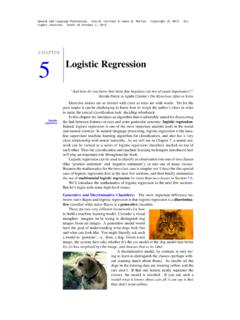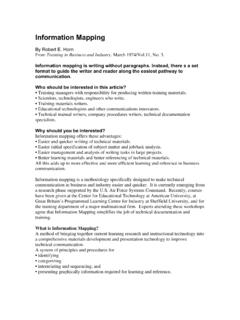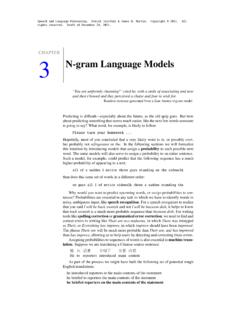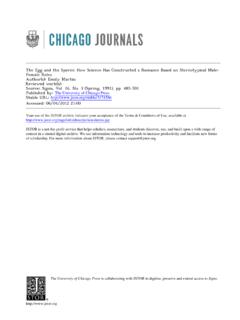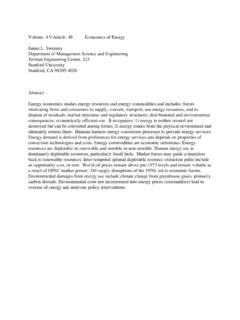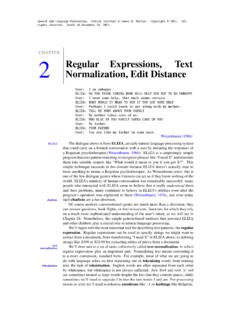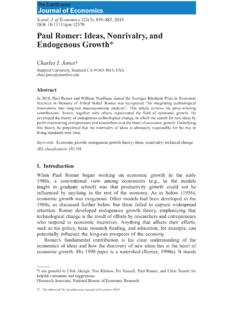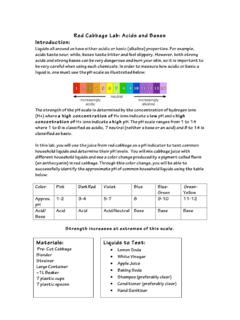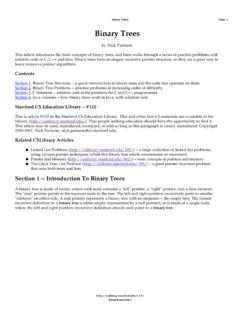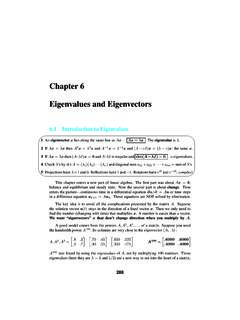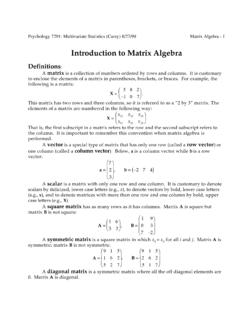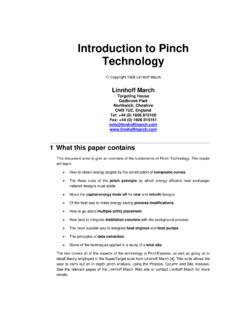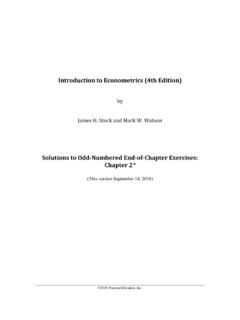Transcription of Introduction to the Theory of Plates - Stanford University
1 Introduction to the Theory of Plates Charles R. Steele and Chad D. Balch Division of Mechanics and ComputationDepartment of Mecanical EngineeringStanford University Stretching and Bending of Plates - FundamentalsIntroductionA plate is a structural element which is thin and flat. By thin, it is meant that the plate s transversedimension, or thickness, is small compared to the length and width dimensions. A mathematicalexpression of this idea is: where t represents the plate s thickness, and L represents a representative length or width dimension.(See Fig. See Plate and associated (x, y, z) coordinate ) More exactly, L represents theminimum wave length of deformation, which can be much smaller than the plate minimum lateraldimension for problems of localized loading, dynamics and stability. Plates might be classified as verythin if t > 100, moderately thin if 20 < t < 100, thick if 3 < t < 20, and very thick if t < 3.
2 The classical Theory of Plates is applicable to very thin and moderately thin Plates , while higher ordertheories for thick Plates are useful. For the very thick Plates , however, it becomes more difficult andless useful to view the structural element as a plate - a description based on the three-dimensionaltheory of elasticity is to the Theory of ~chasst/Course%20 of 414/2/09 2:20 PMFIGURE Plate and associated (x, y, z) coordinate this chapter, we derive the basic equations which describe the behavior of Plates taking advantageof the plate s thin, planar character. The approach is a generalization of the one-dimensional Euler-Bernoulli beam Theory , which exploits the slender shape of a beam. We will develop atwo-dimensional plate Theory which employs the in-plane coordinates x and y in See Plate andassociated (x, y, z) coordinate as independent variables.
3 Of particular interest are the plate s stretching behavior - associated with in-plane loads in the x- and y-directions, and the plate sbending behavior - associated with moment and shear loads applied to the plate s edges, andtransverse loads in the z- See Plate and associated (x, y, z) coordinate depicts a plate and an associated (x, y, z)coordinate system. The top and bottom surfaces lie at z = t/2. The flat surface z = 0 is the platemidsurface, which provides a convenient reference plane for the derivation of the governing equationsfor the ConsiderationsMany things are easier if we begin with the three-dimensional equations of linear elasticity. Thesolutions for three-dimensional problems is generally difficult and time-consuming for a many respects, however, the derivation of the three-dimensional Theory is more straight-forwardthan the reduced approximate beam, plate and shell theories.
4 Indeed, the three-dimensional Theory isthe basis for all approximate theories. The equations can be found in many texts, includingTimoshenko and Goodier, 1970 See Timoshenko SP and Goodier N (1970). Theory of Elasticity, ThirdEdition, (McGraw-Hill, New York)..Stress componentsThe application of external forces to a body produces an internal state of stress. Stress is measured inunits of force per unit area, and can be thought of as the intensity of the internal forces acting at aparticular point in the body. Figure See Stress components acting on the surfaces of a three-dimensional element in cartesian depicts the stresses which act on the surfaces of athree-dimensional element of a solid to the Theory of ~chasst/Course%20 of 414/2/09 2:20 PMFIGURE Stress components acting on the surfaces of a three-dimensional element incartesian components in Fig. See Stress components acting on the surfaces of a three-dimensional elementin cartesian are identified by two indices.
5 The first index denotes the direction of theoutward normal to the surface being acted upon, and the second index denotes the direction in whichthe force acts. For example, zx is the force per unit area of the surface with outward normal in thepositive z-direction and acting in the positive x-direction. The stress components xx, yy, and zzact normally to the element faces, while the remaining six components xy, xz, yx, yz, zx,and zy are the components of shear stresses, which act tangentially to the element faces. On the back faces not shown in Fig. See Stress components acting on the surfaces of a three-dimensionalelement in cartesian , , the faces with outward normals in the negative directions ofthe coordinate axes, the directions of all the components are reversed, as indicated by the component yy. With this sign convention, tensile forces have positive values of stress and compressive forcesnegative authors choose the opposite order for the indices, with the first index giving the direction offorce and the second the face.
6 However, the majority of publications on Plates and shells use thenotation in Fig. See Stress components acting on the surfaces of a three-dimensional element incartesian theoremConsider the cube in Fig. See Stress components acting on the surfaces of a three-dimensionalelement in cartesian to be located in the region of a body with the coordinates: ; ; The total force in the x-direction can be obtained by integrating the components in the x-direction onthe six faces, with the result: Introduction to the Theory of ~chasst/Course%20 of 414/2/09 2:20 PM in which bx is the component in the x-direction of the body force per unit of volume. However, thefirst surface integrals can be rewritten as volume integrals. (This is the divergence theorem forrectangular coordinates.) Thus the equation becomes: Within the body, the subregion can be chosen arbitrarily. For the result of the integration to be zero forany arbitrary subregion, no matter how small or large, the integrand must be identically zero.
7 Thus thepartial differential equations for equilibrium are obtained: in which bx, by, and bz are the components of the body force per unit of equilibrium of the three-dimensional element in Fig. See Stress components acting on thesurfaces of a three-dimensional element in cartesian around each of the coordinate axesleads to the condition of symmetry of the shear stress components for the classical Theory of elasticity: ; ; We mention that for nonclassical elasticity, in addition to a force per unit area, the possibility of atorque per unit area acting on the body is included. For such theories, Eq. See ; ;. does not hold, andthe stress components are not methodThe above derivation is exact. However, a direct method which is often used is to consider theelement in See Increments of the components of stress in the The summation of theforces in the x-direction gives: Dividing by x y z and taking the limit yields Eq.
8 See .. The same procedure yields the other twoequations of to the Theory of ~chasst/Course%20 of 414/2/09 2:20 PM FIGURE Increments of the components of stress in the and DisplacementThe components of displacement in the x-, y-, and z- directions is often denoted by u, v, and w. Thestrain (engineering) is the change in length divided by the original length, which gives the straincomponents in the three directions: ; ; and the components of shear strain: ; ; If two lines that intersect at 90 are scribed on the body, then the change in the angle of intersection isthe shear RelationsThe stress components are related to the strain components by the generalized Hooke s law for anisotropic material: where E is the Young s modulus and is the Poisson s ratio. The shearing strain components are: Introduction to the Theory of ~chasst/Course%20 of 414/2/09 2:20 PM where G is the shear modulus.
9 For the isotropic material, the shear modulus is determined by theYoung s modulus and Poisson s ratio: So both the shear stress and shear strain components are symmetric in the two indices. For a generalanisotropic material, all the stress and strain components are and Moment ResultantsThe nine stress components shown in Fig. See Stress components acting on the surfaces of a three-dimensional element in cartesian uniquely define the state of stress at a point in a three-dimensional body, and are in general functions of x, y, and z. In the Theory for a thin plate, however,we would like to work with force quantities which depend on x and y alone. This can be achieved byintegrating the stresses in the z-direction, through the plate s thickness, in order to obtain thefollowing stress resultant quantities: ; ; ; ; and the moment resultant quantities: ; ; The stress resultants given by Eq.
10 See ; ;. have the units of force per unit length, and act in thedirections shown in Fig. See Force resultants acting on a two-dimensional plate Nx and Nyare in-plane tensile (when positive) stress resultants in the x- and y- directions; Nxy and Nyx arein-plane shear stress resultants; and Qx and Qy are transverse shear stress on the plate in the x-, y-, and z -directions are denoted by px, py, and pz in Fig. See Forceresultants acting on a two-dimensional plate These are the external forces acting on theplate at a given point. External loads can be applied as body forces, such as gravity, and they can beapplied as surface tractions, in which case they correspond to the stresses zx, zy, and zz,evaluated at z = t/2, as shown in the next section. The loads have the units of force per unit area andIntroduction to the Theory of ~chasst/Course%20 of 414/2/09 2:20 PMare functions of x and y.

